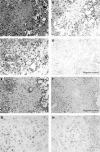Receptor activator of NF-kappaB ligand (RANKL) is expressed in chondroblastoma: possible involvement in osteoclastic giant cell recruitment
- PMID: 12665629
- PMCID: PMC1187303
- DOI: 10.1136/mp.56.2.116
Receptor activator of NF-kappaB ligand (RANKL) is expressed in chondroblastoma: possible involvement in osteoclastic giant cell recruitment
Abstract
Aims: Chondroblastoma is a rare, locally aggressive bone tumour that causes osteolytic destruction at the epiphyseal end of the affected bone. It is possible that tumour cells may stimulate osteoclastogenesis and osteolytic destruction through the production of receptor activator of NF-kappaB ligand (RANKL), which is a key molecule essential for regulating osteoclast formation and activity. Therefore, the expression of RANKL at both the mRNA and the protein level was investigated in chondroblastoma tumour tissue obtained from patients.
Methods: The expression of RANKL gene transcripts was analysed by the reverse transcription-polymerase chain reaction (RT-PCR), and the cellular localisation of RANKL mRNA and protein was demonstrated by means of in situ hybridisation and immunohistochemistry.
Results: RT-PCR analysis indicated that RANKL mRNA was present in all chondroblastoma specimens and normal cancellous bone samples, but not in normal articular cartilage and chondrosarcoma tissues. In contrast, gene transcripts of osteoprotegerin (OPG), the decoy receptor of RANKL, were detected in all types of tissues. The chondroid origin of neoplastic mononuclear cells in chondroblastoma was confirmed by positive S-100 immunohistochemical staining. Both RANKL mRNA and protein were exclusively expressed in these neoplastic mononuclear cells.
Conclusions: These findings suggest that RANKL may be involved in the tumour cell induced recruitment of osteoclast-like cells and consequent osteolytic bone destruction in chondroblastoma.
Figures



Similar articles
-
Gene expression of osteoprotegerin ligand, osteoprotegerin, and receptor activator of NF-kappaB in giant cell tumor of bone: possible involvement in tumor cell-induced osteoclast-like cell formation.Am J Pathol. 2000 Mar;156(3):761-7. doi: 10.1016/s0002-9440(10)64942-5. Am J Pathol. 2000. PMID: 10702390 Free PMC article.
-
Bone stromal cells in pagetic bone and Paget's sarcoma express RANKL and support human osteoclast formation.J Pathol. 2006 May;209(1):114-20. doi: 10.1002/path.1953. J Pathol. 2006. PMID: 16482498
-
Fibroblastic stromal cells express receptor activator of NF-kappa B ligand and support osteoclast differentiation.J Bone Miner Res. 2000 Aug;15(8):1459-66. doi: 10.1359/jbmr.2000.15.8.1459. J Bone Miner Res. 2000. PMID: 10934644
-
New insight in the mechanism of osteoclast activation and formation in multiple myeloma: focus on the receptor activator of NF-kappaB ligand (RANKL).Exp Hematol. 2004 Aug;32(8):685-91. doi: 10.1016/j.exphem.2004.03.015. Exp Hematol. 2004. PMID: 15308315 Review.
-
Chondroblastoma: An Update.Arch Pathol Lab Med. 2017 Jun;141(6):867-871. doi: 10.5858/arpa.2016-0281-RS. Arch Pathol Lab Med. 2017. PMID: 28557595 Review.
Cited by
-
Differential expression of the RANKL/RANK/OPG system is associated with bone metastasis in human non-small cell lung cancer.PLoS One. 2013;8(3):e58361. doi: 10.1371/journal.pone.0058361. Epub 2013 Mar 13. PLoS One. 2013. Retraction in: PLoS One. 2024 Nov 13;19(11):e0314046. doi: 10.1371/journal.pone.0314046. PMID: 23516466 Free PMC article. Retracted.
-
Functional treatment of temporal bone chondroblastoma: retrospective analysis of 3 cases.Eur Arch Otorhinolaryngol. 2021 Apr;278(4):1271-1276. doi: 10.1007/s00405-020-06203-4. Epub 2020 Jul 13. Eur Arch Otorhinolaryngol. 2021. PMID: 32661717
-
Putative multifunctional signature of lung metastases in dedifferentiated chondrosarcoma.Sarcoma. 2012;2012:820254. doi: 10.1155/2012/820254. Epub 2012 Feb 16. Sarcoma. 2012. PMID: 22448124 Free PMC article.
-
A balanced t(5;17) (p15;q22-23) in chondroblastoma: frequency of the re-arrangement and analysis of the candidate genes.BMC Cancer. 2009 Nov 10;9:393. doi: 10.1186/1471-2407-9-393. BMC Cancer. 2009. PMID: 19903358 Free PMC article.
-
Receptor activator of NF-kB (RANK) expression in primary tumors associates with bone metastasis occurrence in breast cancer patients.PLoS One. 2011 Apr 29;6(4):e19234. doi: 10.1371/journal.pone.0019234. PLoS One. 2011. PMID: 21559440 Free PMC article.
References
-
- Unni KK. Benign chondroblastoma. In: Dahlin’s bone tumors: general aspects and data on 11,087 cases, 5th ed. Lippincott-Raven Publishers, 1996:47–58.
-
- Fanning CV, Sneige NS, Carrasco CH, et al. Cancer fine needle aspiration cytology of chondroblastoma of bone. Cancer 1990;65:1847–63. - PubMed
-
- Okajima K, Honda I, Kitagawa T. Immunohistochemical distribution of S-100 protein in tumors and tumor-like lesions of bone and cartilage. Cancer 1988;61:792–9. - PubMed
-
- Fukuda T, Saito M, Nakajima T. Imprint cytology of chondroblastoma of bone. A case report. Acta Cytol 1998;42:403–6. - PubMed
-
- Toyosawa S, Ogawa Y, Chang CK, et al. Histochemistry of tartrate-resistant acid phosphatase and carbonic anhydrase isoenzyme II in osteoclast-like giant cells in bone tumours. Virchows Arch A Pathol Anat Histopathol 1991;418:255–61. - PubMed
Publication types
MeSH terms
Substances
LinkOut - more resources
Full Text Sources
Medical
